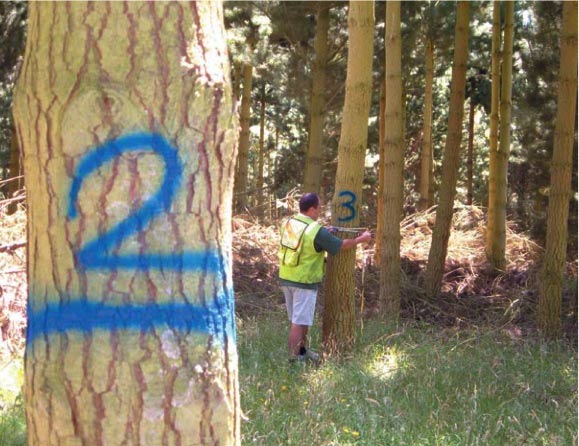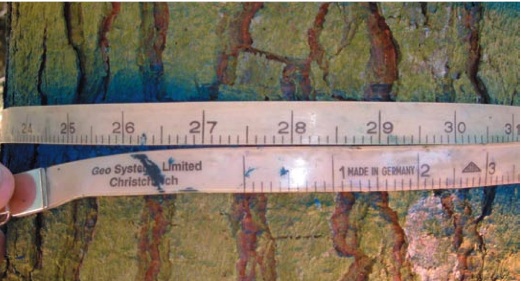Practical hints for measuring trees
Allan Laurie, New Zealand Tree Grower February 2006.
Fundamental to the future decision about harvest is the need to understand how the woodlot is performing in terms of annual tree growth. Growth performance is mainly expressed in height and diameter. This article is about undertaking an annual diameter measurement and then using that information in a practical way.

More than just a quick glance
At the 2002 farm forestry conference in South Canterbury, I gave a presentation on undertaking an annual tree measurement in a standard woodlot. My aim was to encourage farm foresters to get involved in understanding what is happening in their trees and then to record this information for their future.
Pre-harvest or mid rotation stand inventory is typically a comprehensive exercise involving a reasonable level of technical competence and dedicated computer software. However, at a practical and more simplistic level, the farm forester can get involved in understanding how their trees are performing with more than just a quick glance over the fence every so often.
Log grade names
Tree diameter is important to the forester because at harvest time log grades are normally specified by minimum small end diameter (SED). Throughout New Zealand, sawmills have adopted their own log grade names and specifications. Large forest owners will have their own grades and names and invite sawmills to purchase on the basis of these.
Although the suite of log grades and names varies throughout the country the pervading theme is a focus on length and diameter.
As an example, a sawmill will buy P1 or P40 grade sawlogs. These logs may typically vary in length from 3.6 metres to 6 metres and have a minimum SED requirement of 40 cm. Logs with an SED less than 40 cm are relegated to a lower grade and sold to the same sawmill at a lower price or to other sawmills with a smaller log size preference.
Even if trees are not pruned the diameter is still important. Sawmills buying unpruned sawlogs will typically specify SED as a price point and grade criteria. For example an S30 log may be a small branched sawlog with a minimum SED of 30cm. Logs with a smaller SED than this are sold at a lower price. Again grades and names vary around the country but the pervading theme is size means everything.
Size is important
 The size of the standing tree is therefore important to the farm forester because net return is a direct function of tree size. As a practical guide, for pruned trees to consistently yield P1 or P40 sawlogs at maturity, then the trees will need to have a DBH in excess of 50cm.
The size of the standing tree is therefore important to the farm forester because net return is a direct function of tree size. As a practical guide, for pruned trees to consistently yield P1 or P40 sawlogs at maturity, then the trees will need to have a DBH in excess of 50cm.
For those new to the game, DBH means diameter at breast height. This is a standard forest measure. Breast height is typically 1.4 metres above ground, which for most of us is at chest height. In the exercise related here the exact measurement above ground is not critical as long as it is always undertaken in the same place. For trees on hill country the DBH measure is always taken on the top side of the tree.
Just measure 20 trees
In a typical woodlot up to 10 hectares I suggest an annual diameter measurement of a minimum 20 trees is needed to give a broad indicator of growth performance. Most of us would like to measure the largest most impressive trees to satisfy our ego. However these are also the trees that will be likely putting on the most volume. To gain a meaningful average of the woodlot, the trees selected should be a selection across the diameter range. The same trees should be measured within the same two weeks each year. I suggest a birthday is the best as this will always be remembered.
A band should be painted on the tree where the measurement is taken. This ensures the measurement is made in the same place each time. Each tree should be numbered and recorded every time. This enables a review of individual as well as collective tree performance.
A diameter tape is used as in the photograph to measure each tree, with the measurement to one decimal place.
A simple spreadsheet can be set up or handwritten note taken to record the annual event. A summary of the information should include the diameter performance of the smallest tree, the largest tree and the overall average.

 Farm Forestry New Zealand
Farm Forestry New Zealand

